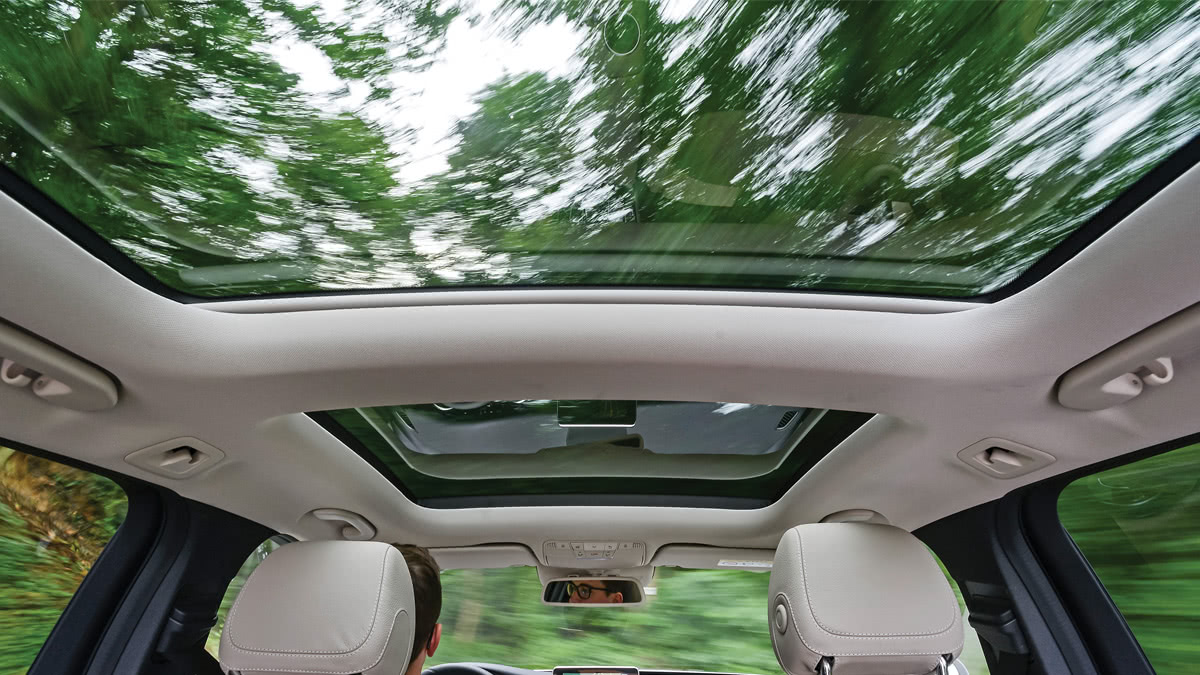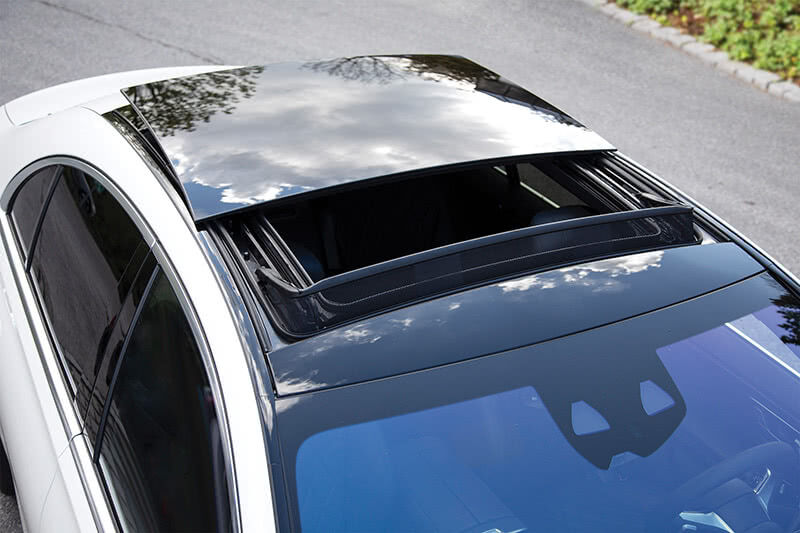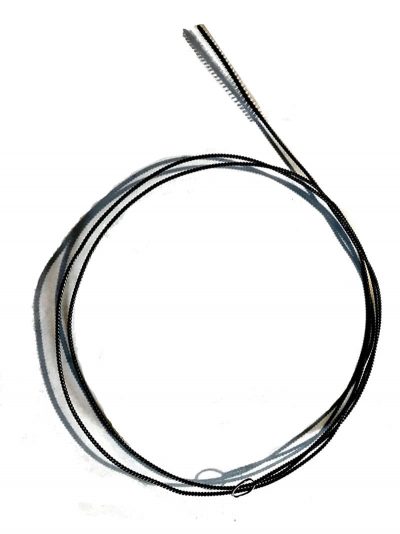What sliding roof systems are installed, how they work, and their maintenance needs
A room with a view — that’s what everybody wants, right? Not just in our homes, but our vehicles as well. The popularity of feeling the wind in your hair and the sun on your face has opened up the many ways engineers try to accommodate this for us without sacrificing safety and ride quality. Hence, the many options offered by Mercedes-Benz for accomplishing this goal. Sunroofs, panorama sunroofs, moon roofs and complete sliding roofs just to name a few. Lots of different terminology out there but all accomplish one goal: getting in touch with nature while driving. There are times however, that we don’t want nature intruding on us — rain and snow storms, high winds, extreme heat, etc. Sliding roof systems can protect us from the elements, but since they move, they need to be serviced and sometimes repaired in order to achieve this great balance of comfort for our customers.
What are the Differences?
Sunroof, moonroof, and panorama – what gives with all the terminology? You may have heard the terms sunroof and moonroof used interchangeably, but there’s a subtle difference between the two. A sunroof is a panel made of glass or metal installed in the roof of a car, truck, or SUV, which slides open or pops up to allow light and air into the cabin. A moonroof is normally a clear or tinted glass panel that slides between the roof and the headliner, and can usually be tilted open to let in fresh air. Panoramic roofs are some sort of combination of both and come with multiple panels in the roof that are either operable or fixed. This design element allows front and rear passengers to open their panel for fresh air and sunlight.
The Latest
Most of what you service will be the older models that have some wear and tear on them, but let’s take a look at what’s in store for the future in your shop. The newest S-Class has an elegant sliding panorama sunroof. The large glass surface provides a pleasing daytime-like feel to the sedan’s interior. There are two separately controllable roller blinds that can shade the interior when necessary. Operation of the modular roof system and blinds takes place conveniently and individually via switch operation or voice control.
There are two roof modules that allow the driver and rear passengers of the vehicle to determine their desired settings individually and independently of each other. All that’s required to open the sunshade is a brief command to the Mercedes-Benz MBUX Voice Assistant or a finger swipe across a panel in the center of the vehicle’s headliner. The front section of the sliding roof can be set to the vent position even at maximum speed. Not only that, it can also be opened completely in a little under eight seconds. Built in to the unit is a wind deflector, which is designed to save installation space and reduce airflow to a pleasant level. The control system for the software is upgradeable – which means the technology is always up-to-date!
MAGIC SKY CONTROL®
MAGIC SKY CONTROL is now in use on thousands of SL and SLK models around the world. The MAGIC SKY CONTROL feature uses patented SPD-SmartGlass technology to turn the roof transparent by electrically aligning tiny particles in a thin film within the glass, avoiding the need for a shade. With the touch of a button, drivers and passengers can instantly change the tint of their roof to help keep out unwanted sunlight and heat, and create an open-air feeling even when the sunroof is closed. Glass or plastic using SPD-SmartGlass technology effectively blocks UV and infrared rays in both the clear and dark modes, helping keep the cabin cooler and protecting passengers and interiors. These benefits become even more important in warm climates.
Mercedes-Benz put the MAGIC SKY CONTROL roof using SPD-SmartGlass technology through rigorous durability and performance testing in some of the most extreme conditions on earth. This included testing in the arctic cold of Scandinavia (with temperatures below -22°F/-30°C) and the stifling desert heat of Death Valley, California (with temperatures exceeding 122°F/50°C). It also blocks over 99% of harmful UV radiation and substantially reduces heat inside the vehicle. Test data published by Mercedes-Benz shows the ability of the roof to reduce sun exposure to 1/20th of direct exposure levels (from over 1,000 watts/square meter to less than 50 watts/square meter). When compared to conventional automotive glass, Mercedes-Benz reported that the use of SPD-SmartGlass significantly reduces the temperature inside the vehicle by up to 18°F/10°C. This increases passenger comfort and reduces air conditioning loads, thereby saving fuel and reducing CO₂ emissions.

Safety Concerns
The MAGIC SKY CONTROL is actuated via a control unit. This control unit includes a DC/AC voltage converter. This uses the 12-volt electrical system voltage to generate 120-volts AC. Because of this high voltage, which can be hazardous to service technicians, certain precautions should be noted. The control unit is marked with a yellow warning sticker on the high-voltage output side. Electrical lines for high voltages are designated by a warning color (orange).
Before starting work on the high-voltage parts of the MAGIC SKY CONTROL, perform the following measures to ensure that the system is not under power:
- Detach the ground of the main vehicle battery. On vehicles with backup battery (ECO start/stop function for example), check whether power is present between Circuit 30 and vehicle ground. If there is, disconnect the backup battery as well.
- Detach the 12-volt connector from MAGIC SKY CONTROL control unit.
- Secure against reconnecting by attaching an HV Warning sticker (W451 589 08 63 00). Cut a sticker off the roll and attach it over the connection surface of 12V connector. The tape is inexpensive and readily available, but if you don’t have any, definitely cover the connector in a tamper-proof way to guarantee somebody doesn’t inadvertently reconnect it.
When the MAGIC SKY CONTROL roof is activated (switched to transparent) do not touch the connector, wiring harness coupling or control unit. If the MAGIC SKY CONTROL roof remains transparent after switch-off, or remains switched on, a malfunction is present. Do not perform any measurements on the system. Work on the system only after ensuring that power to the system has been disconnected.
Do not open the housing on the control unit. If the control unit housing is faulty or damaged, the transparency function should no longer be used. If the high voltage wiring harness (orange) or a connection in the high voltage wiring harness is damaged, always replace complete roof front section of the system. Never insert objects into contacts, the control unit housing or high voltage wiring harness. Keep all fluids away from high voltage parts.
Recalls
Keep an eye out for these models in your shop if you have sunroof complaints. Some may be entitled to return to the dealer free of charge due to a recall. It should be a normal part of writing up every vehicle to check for any open recall campaigns. Visit nhtsa.gov/recalls and type in the VIN to check.
Vehicles affected are:
- Certain 2001-2007 C-Class sedans, wagons, and coupes
- Certain 2003-2009 CLK-Class coupes
- Certain 2003-2009 E-Class sedans and wagons
- Certain 2006-2011 CLS-Class sedans
The issue is that the bonding that keeps the sunroof glass attached to the roof of the vehicle may fail, causing the glass to detach from the car. Mercedes-Benz dealers will inspect and, if necessary, replace the sliding roof, free of charge (as with all recalls).
Function
There are so many models and different builds it would be impossible to diagram the functionality of every single one, so you really need access to the Mercedes-Benz Workshop Information System (WIS), available with a subscription, to the Mercedes-Benz ISP Portal website for exact information on the model you are working on. The XENTRY Diagnosis system would be very valuable here as well, as it contains all the diagnostic testing info for these systems.
We will look at a 204 C-Class model with a power glass tilting/sliding roof in order to get a general idea of the function sequence and built in protections.
First, here are the general Function requirements for the operation of the tilting/sliding roof:
- Circuit 30 (unswitched battery voltage) present
- No overvoltage or undervoltage
The electric tilting/sliding roof (SHD) function allows the tilting/sliding roof to be opened and closed. Operation is accomplished via the tilting/sliding roof switch in the overhead control panel control unit. The SHD is a combined tilting and sliding roof. The sliding roof function drops the SHD down and moves it backwards into the headliner, the tilting roof function raises the SHD at the rear. There are convenience features allowing the SHD to be opened and closed from one central control point. The convenience features are described in the “Convenience feature†(CF) function description.
There are several sub functions of the sliding roof which comprise the following:
- SHD opening/closing
- Anti-pinch protection
- Position monitoring and blockage detection
- Normalization
- Denormalization
- Thermal protection
We won’t go into detail on all these sub functions but let’s look at a few.
Anti-pinch protection is one of those functions often misunderstood by customers, resulting on a complaint. Often the complaint will be “my sunroof reverses itself when I try to close it†or something similar.
For anti-pinch protection to be active, Terminal 15 (switched battery voltage) must be ON, or the run-on time is active (up to 5 min after ignition off, before a front door is opened). Anti-pinch protection operates by comparing the current power consumption of the tilting/sliding sunroof motor with the power consumption recorded during teach-in run or adaptation. If this comparison exceeds a certain limit value during a closing operation, this is detected as a blockage of the SHD by the overhead control panel control unit.
If blockage is detected during a closing procedure, the SHD is stopped and reversed. If blockage is detected during an opening procedure, the SHD is simply stopped. There is a special case during manual closing: If the sliding roof switch is actuated in the closing direction within 2 seconds after reversing, greater force is applied. The anti-pinch protection function is deactivated for the next attempt.
Proper maintenance, discussed later, is essential to smooth operation of the sunroof, helping avoid unnecessary triggering of the anti-pinch function.

Normalization
Sometimes you may receive a complaint that the sliding roof only moves in small steps, taking several switch actuations to get it closed. This is a result of denormalization and is cured by normalizing the system. The sliding roof needs to relearn where fully open and fully closed are. Normalization or resetting the sunroof on some models may be carried out via the overhead control switch (check in the owner’s manual) while others use the Star Diagnosis System or XENTRY Diagnosis.
To complete the normalization function sequence on the 204, manually open the sliding roof via the tilting/sliding roof switch to the tilt position, and then to the rear sliding roof position until the mechanical stop is reached. Continue to actuate the tilting/sliding roof switch for at least one second longer so that the overhead control panel control unit detects blockage of the tilting/sliding roof motor and can set the location counter to zero.
When normalized, the tilting/sliding roof motor is switched off by the overhead control panel control unit before the mechanical stop is reached during automatic opening and closing.
There are several reasons why denormalization may have taken place. It might be a mechanical failure, such as if one of the two hall sensors fails for at least 10 signal edges, or if both Hall sensor signals are missing for longer than 320 ms during roof reversal. Failure may also be customer error, such as trying to operate the sliding roof in an under voltage condition (low battery), or if the battery has been disconnected for some reason.
Maintenance

Maintenance is called for in the general schedule on a regular basis, you’ll need to look up your model but most fall in the ‘every 30k’ range. Cleaning and lubricating the slide rails is what is called for. Your Mercedes-Benz parts counter will have a special lubricant made just for the job (A001 989 46 51), and WIS has detailed instructions. Having a set of small soft brushes to help clean the tracks and rails will come in handy. Also a small syringe with a long tip or extension and a small acid brush will help you apply the lubricant to the hard-to-reach areas. Operate the roof several times while applying and be sure to clean up any excess when done.
Repairs and Adjustments
As mentioned, there are so many models and different build packages within the various models, it would be simply impossible to discuss all the repair scenarios you may run across. WIS, SDS, and XENTRY all have good repair and adjustment procedures as well as the ISP website.
As noted above, one of the common complaints you may run across is the loss of normalization of the roof. The procedure will be fairly simple, provided it hasn’t occurred due to a mechanical problem. Another fairly common complaint is a leaking issue. This is almost never due to a sealing problem but almost always a blockage in the drains, and most certainly due to a lack of maintenance. Cars that are parked outside for long periods of time or under trees will get debris breaking down and getting trapped in the rails. Over time, this gets in the drains and clogs them up causing the rain water to spill over into the vehicle. Cleaning is the answer and can be fairly simple. One important tip here: Do NOT use compressed air to blow out the drains. They are usually steel drain tubes built into the sunroof assembly but connected somewhere with a rubber hose. If the clog is there you will blow off the hose, and now you have a leak there. Now you’ll have to remove a lot of trim to find and reattach it. Instead, a fine wire or very small extended brush and hot water works great. Some techs will add a small amount of dish soap to act as a degreaser as well.
If you find yourself needing to replace a drive motor or cable, one of the most important things you can do is to make sure the sunroof and the tilting and sliding mechanisms all work smoothly by hand while disconnected from the motor and cable drive. Motor or cable failures are not all that common and if they do fail there is likely some binding situation that resulted in the condition. Be sure to check for and correct the problem before replacing the cable and/or motor drive.
Sliding roof systems can be a challenge, but take your time, keep all parts organized, and be sure to have full access to the information systems available from Mercedes-Benz and you’ll have success.









0 Comments